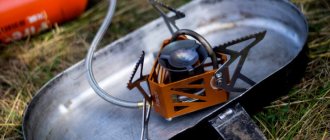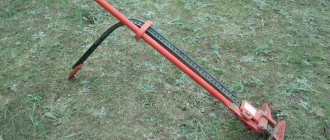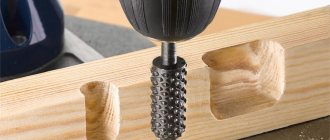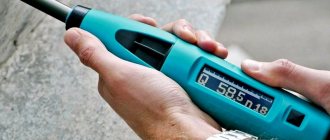Powered by gasoline | 08/09/2018
A blowtorch, as a device for performing a variety of repair and construction work, is still in wide demand. Their popularity is due to their compactness, ease of use, and, subject to proper operation, also safety. We will discuss below how to work with the lamp correctly and maintain it on time.
Types and applications
Depending on the type of fuel used, blowtorches can be gasoline, kerosene, gas or alcohol.
There is also a difference in the volume of the fuel tank. The scope of application of such tools is very wide - from the manufacture and repair of jewelry to use in large industrial sectors.
Blowtorches are most often used in the following cases:
- when soldering metal products with low-melting solders;
- for heating products when welding metals;
- when heating heating systems or water supply systems in case of network failures;
- for heating threaded connections to facilitate their disassembly;
- for heating soldering irons;
- for burning paint and varnish coatings in order to remove them from surfaces.
The most common gasoline and kerosene lamps are similar in design, have similar characteristics and therefore are used, as a rule, in similar conditions.
A gas blowtorch differs from other types in design, and an alcohol blowtorch differs in design and size.
Before choosing which one is best, you need to understand what characteristics and properties these tools have.
To perform work with different materials, it will always be advisable to use one or another type of blowtorch.
Basic Precautions
When carrying out any work with the lamp, you must strictly follow safety rules. The thing is that violating the rules for working with the device can cause it to explode. A blowtorch is presented as a fire hazard. The fuel storage container is located very close to the open flame of the torch itself.
When using the device, you must follow some rules:
- Do not use the tool while detecting gas or fuel vapor leaks.
- It is prohibited to use fuel when using the lamp, which in its characteristics does not meet the requirements of the manufacturer.
- It is forbidden to use the device for a long time, as the proximity of the burner may develop the risk of heating the fuel cylinder above 50 degrees Celsius.
- The device should not be used while the safety valve is faulty.
- It is prohibited to fill the tank with fuel while the burner is burning.
- It is better not to use the device unless absolutely necessary in a closed room; it is unsafe.
It should also be noted that failure to comply with any item from the list of safety rules when using a blowtorch can cause an explosion and unpleasant consequences for a person. You should always follow simple instructions for use, which will allow you to achieve maximum efficiency of the device during its operation.
Dave Hogg, flickr.com CC BY
Despite the widespread availability of electric industrial hair dryers and portable gas torches, a blowtorch remains a simple, convenient and economical way to properly heat something. Until quite recently, anyone who had the slightest ability to work with their hands could light a blowtorch. Nowadays, technical forums are literally filled with questions - how to ignite a blowtorch, why does the blowtorch not work? Let's try to understand this issue in as much detail as possible.
The use of fossil fuels to produce energy has been known since ancient times. Liquid hydrocarbon fuels are especially convenient in this regard. Complete combustion of hydrocarbons should produce only carbon dioxide and water . But this requires that for every kilogram of fuel burned there must be a certain number of kilograms of air.
Ensuring this is not so easy. If you light, for example, gasoline in an open container, it will burn with an orange-red, fairly smoky flame, clearly indicating a lack of air. If air, or even better, pure oxygen, is forced into the torch, the flame will become blue, without soot and much hotter. a kerosene cutter works . A mixture of kerosene and oxygen is supplied to the torch burner, which leads to complete combustion and such a high temperature at which even steel melts and burns.
But for a DIYer, it might not be tempting to tinker with an oxygen tank or air compressor. Is it possible to make sure that the flame itself captures as much air as it needs? You can and this is exactly how a blowtorch .
A blowtorch is a heating device in which the heat of combustion of fuel, in addition to its main purpose, is used to evaporate the fuel supplied to the burner. That is, it is not the liquid fuel itself that burns in the blowtorch, but its vapors entering the combustion zone at high speed. The jet of fuel vapor captures the air around the burner, which ensures that a sufficient amount of oxygen enters the combustion zone.
The great thing about this process is that it is regulated automatically. The more fuel vapor is supplied to the burner, the higher the jet speed and the more air is captured. In some cases, there may be too much air, then it simply passes through the burner, reducing the temperature of the torch. But usually burners are designed in such a way that they cannot pass excessive amounts of air purely physically.
What can you use a blowtorch for?
Previously, a blowtorch was used almost everywhere where high heating of materials was required, because there was simply no other alternative. Now, in many cases, it is more rational to replace the blowtorch with a gas torch or an electric industrial hair dryer. It's easier and safer. But sometimes you won’t be able to reap the benefits of progress. For example, an industrial hair dryer cannot be used in the absence of electricity, and a liquefied gas burner is almost impossible to light in the cold. After all, a blowtorch may already have been in the household since time immemorial, but other tools will have to be purchased. Therefore, the blowtorch still has a wide field of application. A blowtorch is most often used for:
- heating parts and melting solder, heating soldering irons during soldering
- welding materials with a melting point of up to 1000 degrees
- melting metals with a melting point of up to 800-900 degrees
- burning out old paintwork on metal objects
- heating frozen water in water and sewer pipes
- preheating internal combustion engines for starting at low temperatures
- dismantling old rusty threaded connections
- resinous wool on animal carcasses
Gasoline and kerosene
A blowtorch running on kerosene, like a gasoline one, consists of a tank in which the fuel is compressed to several atmospheres, and a burner. During compression, the fuel is partially mixed with air.
Reservoir and pump
The reservoir has a volume of 1-2 liters. Its body has a built-in filler plug, a pump to create pressure and a tube that connects the body to the burner, providing fuel to the latter.
To use the maximum amount of fuel from the tank and reduce the number of refills, the free “receiving” end of the tube is located almost at the bottom. All parts are built into the tank in such a way as to ensure tightness.
The simplest pump design is a cylinder with a piston. At the lower end of the cylinder there is a simple check valve that prevents air from escaping from the reservoir.
The piston is a cup-shaped cuff that compresses air when moving towards the cylinder valve, and when moving in the opposite direction, it allows air to flow, filling the cylinder.
Burner device
The burner consists of a nozzle, a control valve, an ejector tube and an ignition cup. From the injector, fuel is injected under pressure into a tube in which it is mixed with air captured from its rear hole.
To ensure complete combustion of the fuel, it must first be heated. This is ensured thanks to the design of the ejector tube. Fuel under pressure, before reaching the injector nozzle, is heated in the “jacket” of the tube, inside which a flame burns.
The initial heating of the tube is carried out when preparing the lamp for operation by igniting the fuel in the bowl. The adjusting screw ensures the required flame temperature by limiting the amount of injected fuel.
Fuel requirements
Fuel for use in a blowtorch must be clean, otherwise mechanical impurities may cause clogging of the nozzle.
For the same reason, it is recommended to use gasoline with a low octane number, as it contains fewer additives.
If the hole is clogged, it can be cleaned with a soft wire of suitable diameter. Steel wire should not be used so as not to damage the nozzle by changing its geometry. Very often, gasoline and kerosene blowtorches come with a special wire cleaner.
The difference between a gasoline and kerosene blowtorch is the diameter of the nozzle hole. In addition, in older designs of kerosene blowtorches, a small coil was located inside the ejector, which allowed the fuel to be heated more intensively. This design was a consequence of the fact that the combustion temperature of kerosene is slightly lower than that of gasoline.
Start and end of work
To start working, the device must be filled with fuel in an amount of no more than 2/3 of the volume of the fuel tank, and pressure must be created using a pump.
Then you should fill the burner bowl with fuel and carefully set it on fire. As the burner warms up, slowly open the control valve and increase the pressure in the tank.
When the fuel stream ignites, the nozzle nozzle must be directed into a fireproof, refractory surface, such as a brick wall or a sheet of asbestos. This will speed up the heating of the burner.
After completing the work, the flame is extinguished by stopping the fuel supply to the nozzle. Only after the lamp has cooled can the fuel tank be opened. It is allowed to refill the lamp if its temperature does not exceed 50 ℃.
How to use a blowtorch?
The safety of a gasoline blowtorch is also ensured by the fact that it is difficult to ignite the mixture directly in the burner, since the volatility of gasoline at ordinary room temperature is insufficient for ignition. Therefore, after checking the functionality of the device, the llama is pre-ignited. To do this, pour a little gasoline into a special cup and place it under the burner. The gasoline is set on fire, and when the flame begins to die out, the fuel supply valve is opened. Under the influence of internal pressure, the mixture leaves the nozzle nozzle, enters the zone of heated air containing gasoline vapor, heats up and spontaneously ignites. Then, using the control valve, the degree of extension of the needle in the burner is changed, which regulates the length and intensity of the torch.
The volatility and low density of gasoline provide sufficient conditions for its self-mixing. However, it is impossible to completely fill the tank with gasoline: it is necessary to ensure excess pressure of gasoline, which will be sufficient for its stable flow to the control device. In some designs, designed for lower values of excess pressure, not only a guide tube, but also a wick is provided for transporting gasoline.
The booster pump moves in rubber seals. To prevent them from becoming unusable ahead of time, the movements of the handle should not be sharp.
The duration of reliable operation of a blowtorch also depends on the type of mixture used to heat the lamp. For example, gasoline, even high-octane gasoline, contains organic compounds that, when burned, produce carbon deposits on the surface of the burner. Therefore, experts advise using ethyl alcohol for this purpose.
Lighting a gasoline blowtorch must be done outdoors, but without wind or drafts. If, after pumping and opening the tap, a vaporous mixture comes out of the nozzle, then its parameters are sufficient for ignition with a regular match or lighter. On the contrary, if liquid comes from the nozzle, then dispersing the mixture is not enough, and preheating it is required.
Gas
A gas blowtorch works using liquefied propane or butane, packaged in metal cans, as fuel. In this case, the tool itself is usually a portable burner, and gas cylinders can be purchased separately.
All connecting connectors of burners and cylinders are unified, and almost all cylinders are easily connected to any type of burners.
The burner of such a blowtorch is a tube open at one end (this is the burner nozzle). On the other side there is a nozzle mounted.
There are also several holes for drawing air into the nozzle and subsequent mixing with gas, which is necessary to create a flame with a high temperature. The temperature and flame intensity are adjusted using a tap located on the burner body.
Operation of such a device begins with opening the tap to an amount that allows a small amount of gas to be released from the cylinder, and igniting it with a lighter or match.
For intensive use and if it is necessary to frequently ignite and extinguish the flame, it will be more convenient to use a gas blowtorch with piezo ignition.
see also
Comments 52
A blowtorch is an extremely necessary and quite simple thing; you just need to follow a small number of simple rules. Now large tablets with dry alcohol are sold; one is enough to light up a lamp after a long break and then work for a whole day (with breaks of up to 2 hours). This way the lamp does not smoke, and if you create minimal protection from the wind, the diffuser warms up much faster. I don’t remember the technology of their production very well, but I remember that about 30 years ago ALL blowtorches ran on gasoline, and occasionally there were those on sale that could run on a mixture of gasoline and kerosene (!) and very rarely the so-called. “omnivorous”, into which you could even pour diesel fuel. At one time, I also poured solarium sometimes out of desperation, but it was necessary to select the diameter of the nozzle (in my lamp it was screwed into a thread inside a U-shaped tube that approached the diffuser from above) and the pressure created inside the lamp (under some conditions it started to get terribly smoke). I mostly used my lamp in tandem with a Taganka for quickly heating large amounts of water, cooking bitumen for roofing and waterproofing work, and simply for cooking food when camping with a large group. I want to especially focus on the latter: - often on a hike or on vacation there is a friendly group of people of 5-10 people. and feeding them is not so easy at first glance. You can, of course, chop up a bowl of lettuce and feed sandwiches to everyone, but such food won’t last long, and it doesn’t even make for a full lunch. You can “stir up” an improvised stove-hearth on a fire using a tripod, but not all dishes can be hung on it; frying pans and thin-walled aluminum pots and kettles are also useless (they will become smoked on top, and everything will burn inside). Of course, if you go on a hike on your own and carry everything on yourself, then there are no pickles and you often have to get food for yourself in the forest. But if you travel by car, and especially with children, and especially in the cold season, then a full hot diet is a must! And here, as a camp kitchen, a powerful blowtorch, taganok and a universal cast-iron cauldron (with an aluminum lid, it is still lighter, and the role of the lid of the cauldron is not even secondary, but tertiary) 8-12 liters. Many people thought that the fig is so big and heavy (and a normal cast iron cauldron of 8-12 liters will weigh at least 10 kilos!), but the point is that the peculiarity of cooking in this category of cookware rarely allows you to use it comfortably , loading more than 60% -70% of the capacity. Today, such a cauldron can be heated only with the help of a good fire, a specialized gas burner from 4 kW, or using a blowtorch and a taganka. The thickness of the walls of a cast iron cauldron is at least 5 mm, and at the bottom it reaches 1 cm, so it makes no sense to even try to cook with it on the usual tourist tiles. Pilaf, fish soup, various porridges, shurpa, kharcho soup and many other dishes can always be prepared relatively simply and quite quickly, but nothing sticks to a normal cast-iron cauldron, it retains heat for quite a long time, and the blowtorch itself, taganok and cauldron are virtually eternal and trouble-free. One refill of a 2-liter lamp was enough for me to cook pilaf for 6-8 people (1.5-2 kg of lamb, pork or beef tenderloin, 1-1.5 kg of steamed rice (that’s what it’s called in store), rinse it thoroughly with several changes of water, pour in a small amount of boiling water for an hour and then start lighting the lamp and cooking the pilaf itself). The cooking process takes 1-1.5 hours, but you get a hearty lunch or dinner for the whole company.
Advantages of gas burners
The main advantage of a gas lamp is undoubtedly its light weight and small size. The second positive quality is the minimum preparation time for work.
You can work with such a tool at heights, in confined spaces; only good ventilation is necessary if work is carried out indoors.
There are models of gas blowtorches without replaceable cylinders. They are hand-held torches connected by a hose to a large-capacity cylinder. Such lamps can be used to work for a long time, when it is not possible to interrupt them to change the cylinder.
The design of a gas blowtorch is so simple that many craftsmen assemble homemade burners using sections of copper pipes and fittings - elbows, fittings, taps. The finished burner is connected to a household propane storage cylinder with a gas hose using a pressure regulator.
Alcohol
These instruments are now extremely rare. They are mini blowtorches with a 150-200 ml tank, refilled with alcohol.
The design of such lamps is simple - a reservoir and a burner. There is no pump, and the pressure in the tank is created due to a slight increase in the temperature of the housing.
To do this, a small amount of fuel is burned in a recess in its upper part. Further, the operating mode is maintained by the burner temperature.
Such blowtorches are used for precision soldering when repairing jewelry, radio devices, and antennas. However, the production of alcohol lamps is reduced to a minimum, as they are replaced by convenient miniature gas burners.











